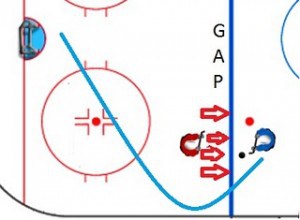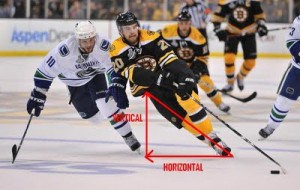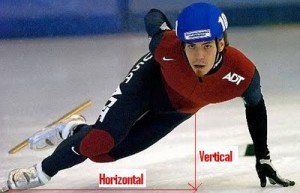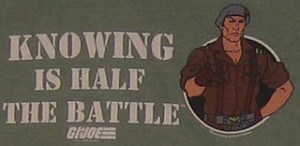12 Aug Driving the Net
Posted at 15:01h in
Dr. Hockey by Jim Vitale Doctor’s Diagnosis: Get to the slot = Earn a shot!

I’ve been thinking a lot lately about all the wonderful online skills that exist, wonderful flips, drags, spins and fakes, and realized one thing…
Driving the Net is a Lost Art!
I remember being a child playing hockey for a coach who was a huge Bobby Orr fan and wondering at what point we were going to learn anything other than crossing over hard into the slot with one hand on the stick and the and the other sticking out to protect the puck. It wasn’t until my playing days at Benchwarmia University that I realized the value of busting through the slot like a bat out of hell to avoid being angled into the corners. So, I’ve decided to dig up this lost art and investigate when do you drive the net, and what turns an ordinary approach at the net into an absolute path of destruction that ends up in a G-note!
1) To drive or not to drive?
First off, a forward crossing the blueline on the attack is a mere spectator unless he is actively gauging the distance between the D-Man’s toe caps and the blueline… a.k.a. the Gap (insert big echoing voice here). A tight gap means you have no choice but to bust wide and be prepared to engage in an epic battle for the space behind the D. You can bet your bottom dollar (Think Little Orphan Annie has that copyrighted?) that the D is going to pivot out to get you and isn’t going to be in that great of a mood!
2) Where do we go now? (Bet you can’t help hearing Axle Rose’s voice in your head while you read that)
 At this point your North/South journey quickly changes to East/West and a few unavoidable forces of nature take control. The first is a defenceman’s best friend, a scientific principal known as “Inertia” and the second is centrifugal force, which is on your side if you can figure out how to harness and control it! Remember when you were a kid driving in the back seat of a car and the driver thought it was hilarious to quickly change direction and send you slamming into the far door of the car, or better yet little brother or sister? Unbeknownst to you, you weren’t changing direction as you flew across the seat, the car was changing around you: your body was actually remaining along the original path that the car was travelling. Inertia then, is any resistance of any mass to a change in direction, or desire to remain along the original path. When you accelerate hard down the boards, you’ve set your momentum along a linear path directly into the corner! The defenceman loves you for this because it takes a lot of skill to overcome this linear momentum when you decide to start crossing over on a curved path into the slot! It takes an aggressive commitment to changing your momentum in order to minimize the natural pull to the outside… you better be willing to lean!
At this point your North/South journey quickly changes to East/West and a few unavoidable forces of nature take control. The first is a defenceman’s best friend, a scientific principal known as “Inertia” and the second is centrifugal force, which is on your side if you can figure out how to harness and control it! Remember when you were a kid driving in the back seat of a car and the driver thought it was hilarious to quickly change direction and send you slamming into the far door of the car, or better yet little brother or sister? Unbeknownst to you, you weren’t changing direction as you flew across the seat, the car was changing around you: your body was actually remaining along the original path that the car was travelling. Inertia then, is any resistance of any mass to a change in direction, or desire to remain along the original path. When you accelerate hard down the boards, you’ve set your momentum along a linear path directly into the corner! The defenceman loves you for this because it takes a lot of skill to overcome this linear momentum when you decide to start crossing over on a curved path into the slot! It takes an aggressive commitment to changing your momentum in order to minimize the natural pull to the outside… you better be willing to lean!
3) Use the force!
Any moving body has 2 components to and force that acts on it: One Vertical and One Horizontal. Basically put, the stiffer you stand, the more the vertical force acts on you (Gravity). Likewise, the more you lean, the more the horizontal force comes into play. Everyone knows, Newton’s third law that every force has an equal and opposite force (Do they really?), so it’s obvious that in a net-driving situation, we want the force we are pumping out with our legs to result in a force coming back from the ice with a huge horizontal component! Well you gotta be willing to lean like a mofo in order to allow this to happen. Now let’s face it’s not possible to lean as much as a speed skater within the realms of
ice hockey, but you get the idea…

“The more you lean, the more of the force produced by your massive tree trunk sized quads gets transferred into making move toward the center of the curved path you are on. Likewise, the straighter you tand, the more gravity works to keep you stapled to the ice along a linear path!”
The moral of the story… don’t be shy to experiment with leaning in practice and push your limitations… don’t be afraid to fall!
 At this point your North/South journey quickly changes to East/West and a few unavoidable forces of nature take control. The first is a defenceman’s best friend, a scientific principal known as “Inertia” and the second is centrifugal force, which is on your side if you can figure out how to harness and control it! Remember when you were a kid driving in the back seat of a car and the driver thought it was hilarious to quickly change direction and send you slamming into the far door of the car, or better yet little brother or sister? Unbeknownst to you, you weren’t changing direction as you flew across the seat, the car was changing around you: your body was actually remaining along the original path that the car was travelling. Inertia then, is any resistance of any mass to a change in direction, or desire to remain along the original path. When you accelerate hard down the boards, you’ve set your momentum along a linear path directly into the corner! The defenceman loves you for this because it takes a lot of skill to overcome this linear momentum when you decide to start crossing over on a curved path into the slot! It takes an aggressive commitment to changing your momentum in order to minimize the natural pull to the outside… you better be willing to lean!
At this point your North/South journey quickly changes to East/West and a few unavoidable forces of nature take control. The first is a defenceman’s best friend, a scientific principal known as “Inertia” and the second is centrifugal force, which is on your side if you can figure out how to harness and control it! Remember when you were a kid driving in the back seat of a car and the driver thought it was hilarious to quickly change direction and send you slamming into the far door of the car, or better yet little brother or sister? Unbeknownst to you, you weren’t changing direction as you flew across the seat, the car was changing around you: your body was actually remaining along the original path that the car was travelling. Inertia then, is any resistance of any mass to a change in direction, or desire to remain along the original path. When you accelerate hard down the boards, you’ve set your momentum along a linear path directly into the corner! The defenceman loves you for this because it takes a lot of skill to overcome this linear momentum when you decide to start crossing over on a curved path into the slot! It takes an aggressive commitment to changing your momentum in order to minimize the natural pull to the outside… you better be willing to lean! “The more you lean, the more of the force produced by your massive tree trunk sized quads gets transferred into making move toward the center of the curved path you are on. Likewise, the straighter you tand, the more gravity works to keep you stapled to the ice along a linear path!”
“The more you lean, the more of the force produced by your massive tree trunk sized quads gets transferred into making move toward the center of the curved path you are on. Likewise, the straighter you tand, the more gravity works to keep you stapled to the ice along a linear path!”






Sorry, the comment form is closed at this time.